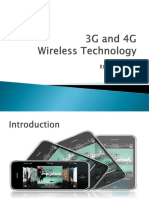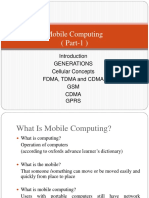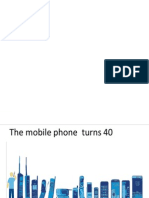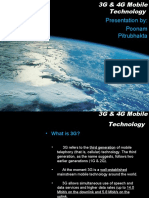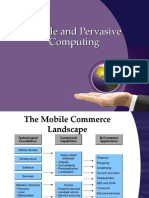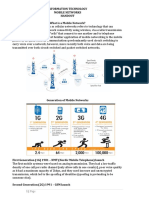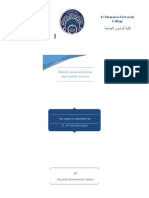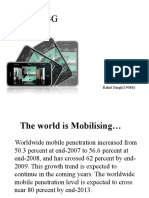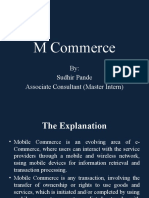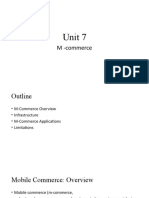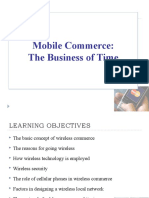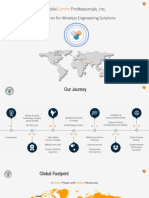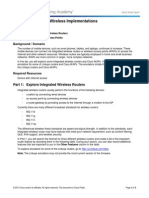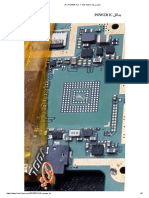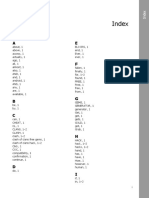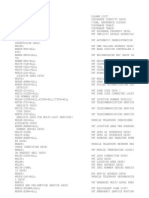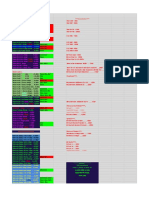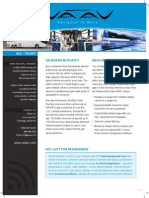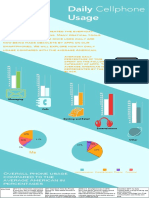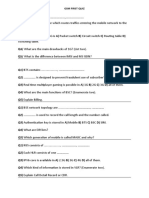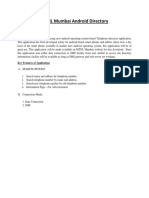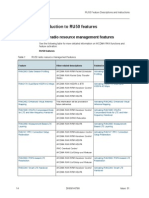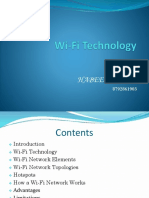Mobile Commerce
New Opportunities for B2B and B2C Services Offered by New Mobile Communication Technologies
Dane Marjanovic Christoph Mller Thomas Schnenberger
�Timetable
Mobile Technology Mobile Market Forecast into 4th Generation
�A short history of mobile communication
1958 in Germany, the A1 net was established
In 1970 it has had a coverage of
80% of the area and 95% of the population in Germany.
The limitation was by 11000 users 1986 the network was working to full capacity of 27000
In 1972 an new net was established
�A short history of mobile communication
1986 the third analog network was established The limitation was by 400000 costumers in Germany 31.12.1999 Swisscom stops the network
�A short history of mobile communication
In 1982 the European Conference of Postal and Telecommunications Administrations founded a working group. 1987 the Global System for Mobile communications standard was available 1991 in Switzerland the first devices are presented In 1995 SMS was available
�GSM
The DCS-900 standard has 124 channels The DCS-1800 (established in 1995) has 372 channels. Each channel has 8 slots Each slot has a capacity of 9600 bit/s
2G
�HSCSD, GPRS und Edge
HSCSD stands for High Speed Circuit Switched Data
Use more slots for one connection Uses simple error correction and has a speed of 14400 bit/s It has different service classes and the user is always online
GPRS stands for General Packet Radio Services
2.5G
�HSCSD, GPRS und Edge
Edge stands for Enhanced Data Rates for GSM Evolution
It accelerates the data communication up to 473,6 kbit/s It needs new technology on the operator side
2.5G
�UMTS
UMTS stands for Universal Mobile Telecommunication Service
The maximum data transmission rate is 2 Mbit/s Simpler extension of the net Break-through of the technology in the year 2010
3G
�SMS, MMS and WAP
SMS stands for Short Message Service
The message payload is 140 bytes By 2004 more 500 billion messages were sent per year. In the year 2000 just 17 billion were sent. The most frequenter texters are in Singapore. About 2300 SMS per year in 2003
�SMS, MMS and WAP
MMS stands for Multimedia Messaging System
MMS was originally developed for 3G
WAP stands for Wireless Application Protocol
�iMode
iMode was developed by DoCoMo in Japan It was launched February 22, 1999 There are 3000 content-providing companies for iMode August 2004 there were 43 million customers in Japan, and over 3 million in the rest of the world
�PDAs
PDA stands for Personal Digital Assistant Three different Operating systems are available:
Palm OS was developed by US Robotics
By August 2003 there where more then 19000 applications available real-time operating system runs also under Smartphone under or the Sega Dreamcast
Windows CE is a variation of Microsoft's Windows
Symbian OS was original developed Psion by the name EPOC
�Timetable
Mobile Technology Mobile Market Forecast into 4th Generation
�Mobile Commerce
M-Commerce vs. E-Commerce
in the broader sense:
Mobile Business vs. E-Business Electronic Commerce:
in the narrower sense:
buying selling marketing and servicing of products or services over computer networks electronic commerce made through mobile devices
Mobile Commerce:
�Market Overview
Mobile users: 1.48 billions (German: Milliarden)
double the users of the year 2000 more than fixed subscribers (1.18 bn) essential growth in China, India and Russia China: 310 millions of mobile users
Compare: population of USA: 293027571 (July '04)
Revenues of approx. CHF 488 bn (CHF 330.-/person) 102 users with broadband internet
Internet Users: 699 millions
Source: TagesAnzeiger, Newsticker, 9.12.04 17:21
�Content Creation
What type of content should be provided?
Text Audio Graphics Video
SMS-news-service MP3-download MMS-weather-service video conference, movie-download
Benefits of these digital medias:
modifiable repetitively consumable by the same user & by others fast and cheap to reproduce
�Content Creation
Issues
Interactivity Customization Time-dependency
Real-time brokerage service Translation service
Intensity of use Operational format Pricing Externalities
Who else could benefit?
�Content Packaging
Aggregating and transforming information for distribution E.g. sports, games, finance, entertainment, news, shopping, travel Customized time- and location-sensitive planning
yellowbrix.com
�Market Making
B2C: Mobile Portals
Content & Services
Communication Personalized content: alerts, news, stocks, betting Personal Information Management (PIM); Filofax Location specific information Webpage vs. Mobile-Page
Issues
~25 Links/page vs. ~5Links/page
�Market Making
But who develops portals?
Mobile operators
Strong position
Vodafone live Debitel SonyEricsson Nokia Yahoo AOL Excite
Virtual operators
Technology vendors
Traditional Web-Portals
others...
�Customer Segments
B2C
Solutions
B2B
Sales driven
Mobile Workforce Mobile CRM Mobile SCM
Manufacturing, banks Consultancies, system houses Taxi, courier
Service driven
Logistics driven
Mobile transactions
Teens ( 18 years) Mobile Entertainment Students (18 25 years) Mobile Information Young business people (25 36 years) Mobile Communication
��Mobile Services Overview
Key improvements
Location specific information Personalization Immediacy Service availability M-Messaging M-Advertising M-Emergency-Services M-Tailing M-Finance M-Payment M-Information E-Mail, SMS, Instant Messaging Sponsored Alerts, Mobile Promotion Child Tracking Ticketing, Reservation M-Brokerage, M-Banking M-Cash Traffic, News
High Potential Services
�Pricing
Pricing by time
Phone call GPRS iMode (DoCoMo) sunrise myzone
Pricing by data volume
Pricing by Service
Pricing by location
�Payment
Mobile operators who allow to charge to the telephone bill Some banks come with their own solutions Visa, Barclays Banks etc. are experimenting
Visa Cash-Smartcard
PrePaid-Solutions
load with Credit Cards
�Timetable
Mobile Technology Mobile Market Forecast into 4th Generation
�Anytime, Anywhere, Anything
4G WIRELESS DEVICES
�Content
The 4G- Issues
Problems Open Questions Introduction Anything Goes Big Brother Pocket Computing
The Scenarios
The Outlook
�The 4G-Issues
Support of global roaming across multiple wireless and mobile networks
Single device, single bill, overall access IP- Interoperability and bitrates of 50 Mbps and more...
Network architectures QoS
Handoff delay End-to-End- QoS
Design 4G as previous systems just with more bandwidth? Mixture of a variety of infrastructures
�The 4G-Issues
Possible Architectures:
Multimode devices
�The 4G-Issues
Possible Architectures:
Overlay network
�The 4G-Issues
Possible Architectures:
Common access protocol
�Scenarios
Intro
First, an overview of the whole technological, political and economical system in 2010 is given. This offers a bird's eye view of technological systems, regulations and general development. Second, a scene in telecommunication business is depicted. Here the aim is to show what kind of issues that are relevant to the business actors. (B2B) Third, the life of an ordinary citizen is described. (B2C)
Scenario aim: to create an awareness of which future developments are possible
�Anything goes
Society and technological development
Generic HW Problems are solved trough SW adaptations Terminals, or access tools
capable of using several different types of wireless networks to access the demanded services. groups of small firms or housing estates
small niche operators offering fairly local wireless networks, aiming at
most large corporations have their own wireless LANs at their facilities. many consumers decided to use miniature wireless LANs to cover their homes or their workplaces at home. terminals capable of operating with many network infrastructures, services that adapt the man machine interface (MMI) based on what type of access node is being used, etc.
�Anything goes
Inside telecommunication business
Selling a new communication tool to a small telecommunication operator Mr. Anders
Everyday life
Has WLAN Tool for home Wants interactive sleeping device an opaque and transparent virtual image, a virtual desk and keyboard, integrated microphone and earphones using speech recognition.
Virtual Vision glasses
�Anything goes
Globalization
World wide communication Main product is software Companies to sell products globally De-facto-Standardization takes over
Standardization
Appliances communicate among each other
�Big Brother
Essence of scenario
Market is limited and controlled by political authorities Personal Integrity is no.1 priority in all systems, Global security control performed by international governmental organizations. Limited markets. Low development rate. Very few operators.
�Big Brother
Society and technology development
Security of the individual was threatened Buy information from traders(companies specialized in collectig information and selling it Authorities had to act:
Govs hat strong legislative control by 2009 over comm resources (frequency bands and encryption)
Computer security was not made safe New security standards were made Companies split into decentralized divisions working with authorities in each country
�Big Brother
Inside telecommunication business
Telecommunication operator and telecommunication manufacturer New base stations for a network shall be bought standards haven't changed, so no change in base- stations Programming interfaces as a topic Demand for mobile data communication is fairly stable UMTS as a standard to handle most of the requirements
�Big Brother
The everyday life and private sphere
Mr. Anders at home:
Printing a registered copy of the daily newspaper Not revealing personal interests
ID-Card for all sorts of payment and identification Mr. Anders at work:
Sending mail
Governmental restrictions made many information providers vanish Yet very personal information can be available to government organs
ID- Cards
Government restricts private sphere by restricting media content being shown on, for example, restricting pay-per view TV
�Big Brother
Information trading
Potential risks At some point degeneration and sensitive information can be available Access to sensitive information becomes to easy Decreased
Globalization
Authorities limit cross-border communication
Standardization is increased New integrity and encryption policy
�Pocket Computing
Essence of Scenario
Market is developed and controlled by operators Social and political differences Bandwidth still expensive Highly differentiated service and pricing levels Specialized service providers also provide equipment for specialized purpose Global multi-purpose services compete with local specialized services
�Pocket Computing
Society and technological development
Technological background:
IMT-2000 Universal mobile idea never to reach the expectations Large variety of different mobile solutions are available The different wireless networks compliment each other, but multimode solution is relatively expensive. Common people prefer to pay for reduced services at minimum price. Hidden communication (cars, household appliances, etc...) Products are marketed worldwide Importance of culture in economical issues increases
Economical Background:
�Pocket Computing
Inside telecommunication business
Small companies competing locally and end up by being bought by larger companies A merge is being discussed
Increasing WLAN use Idea of a non-cellular mobile phone/data network
Extending the network world wide Getting political influence Focus on business customers
Trough reliable and fast access
�Pocket Computing
Everyday-life and private sphere
The Businessman
World wide clients Internationally traveling Notebook always connected to the company
Multi-mode phone modem Reliable and fast access
Premium prices
The new middle class
New generation user Different services at different quality levels are being offered
�Pocket Computing
Standardization
Ruled by big operators
Development of Communicating Appliances is slow
�The Outlook
Technology development Social Structures Current Infrastructures vs. 4G Infrastructures Open Questions
�Discussion
Mobile Commerce
�Differences:
E-Commerce vs. M-Commerce
e-commerce with computer = m-commerce with mobilephones?
m-commerce will not only expand its share of this [ecommerce-]market, but will expand the market overall, through the rapid uptake of m-commerce services Why? How will it expand the market? Europe? USA? Japan?
Key trends are from
�Which Market is growing the fastest and why?
Europe? Asian-Pacific-Region? Thus, we believe that Europe and Asia will be at the forefront of the development in m-commerce and about 2 years ahead of the US.
Durlacher Research 2000 Frequency band? GSM? UMTS?
Technical Standard
�What could be the 4G Implications on everyday life?
Where does privacy begin?
Will there be any private life?
Are there any secure personal data? Work at home: relief or isolation? How big is the willingness to pay premium prices for higher data-rates?
�What Devices/Applications could be useful and in which environment?
Virtual Vision Glasses for:
Work at home, shopping, driving, conferencing Wake up service, Household- maintenance, shopping advice, ...
Intelligent Home Agents (Applications) for:
�Is there any Killerapplication?
The initial killer application for mobile internet services will be e-mail based on the current success of SMS (Short Message Service), which is necessary to pave the way for more transactional m-commerce services.
Durlacher Research 2000 Has it become true?
Will Instant Messaging be the killer-application? or Audio/Video-Download
Mobilephone as MP3-Player? Mobilephone as Video-Player?
or Mobile Banking?
�Addendum
more about M-Commerce
�Pricing Schemes
�Transmission Speeds
Hype or Reality?
�Prediction of Speeds in 4G
Major Requirement Driving Architecture Network Architecture 3G (including 2.5G) 4G Voice driven; data was always add- Converged data and voice over IP on Wide Area Cell- Based 384 Kbps to 2 Kbps 1800- 2400 Mhz 5- 20 Mhz W- CDMA; 1xRTT; Edge Hybrid - Integration of Wireless LAN (WiFi, Bluetooth) and wide area 20 to 100 Mbps in mobile mode Higher frequency bands (2-8 GHz) 100 MHz (or more) All digital with packetized voice OFDM and MC-CDMA (Multi Carrier CDMA) Concatenated coding scheme Smarter Antennas, software multiband and wideband radios All IP (IP6.0)
Speeds Frequency Band Bandwidth
Switching Design Basis Circuit and Packet Access Technologies
Convolutional Rate 1/2, 1/3 Forward Error Connectio Component Design IP Optimized antenna design, multiband adapters Air link protocols incl.IPv5.0
�References
wikipedia.org m-lehrstuhl.de tagesanzeiger.ch Mobile Commerce UMTS Report
Report, Durlacher Research Ltd, www.durlacher.com
An Investment Perspective, Durlacher Research Ltd, www.durlacher.com







